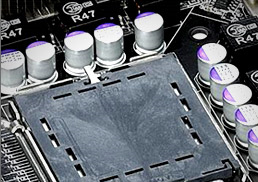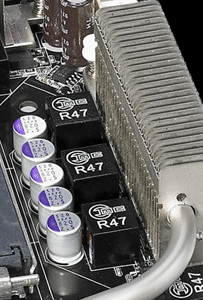Asus P5N32-SLI: Dual x16 - What Dreams Are Made On . . .
by Gary Key on October 27, 2005 12:05 AM EST- Posted in
- Motherboards
This line as spoken by the magician Prospero in William Shakespeare's whimsical play, "The Tempest", reminds us of the uniqueness of the human mind and the fleeting amount of time that we are around to utilize it."We are such stuff, As dreams are made on and our little life
Is rounded with a sleep..."
The Asus P5N32-SLI Deluxe that we will review today is also very unique in several ways and like most computer products in the current marketplace, its life span will be fleeting. However, for those of you who have the opportunity to utilize it, you will find what dreams are made on.
I will say this up front; this is one of the better motherboards that I have had the opportunity to use in the last 20 years. In fact, this board deserves additional testing time in order to explore fully and extract all of its performance potential. In keeping with what we believe is the best option for the current Intel processor lineup, the Pentium D series, we did not test a single core processor on this board. However, based upon the results that we extracted from the 840EE and 820D processors, we will be testing a single core processor on this board in the near future.
While it does not have the quad graphics capability of the Gigabyte GA-8N SLI Quad, the stellar layout of the MSI P4N Diamond, or the extensive feature set of the Gigabyte GA-8I955x Royal that was reviewed recently, this board's capability more than exceeds the sum of its parts. Yes, it does have some quirks as most products will, but Asus has engineered a truly remarkable motherboard utilizing the revised NVIDIA nForce4 Intel Edition SLI for the Northbridge and the NVIDIA nForce4 SLI for the Southbridge resulting in the x16 designation.


 |
 |
One of the main design features that Asus engineered into this board is an exclusive 8-phase voltage regulator power design that can significantly lower operating temperatures while reducing input ripple current and output ripple voltages . In fact, the input ripple current is over three times lower than a traditional 4-phase design while output ripple voltages are four times lower. The power consumption compared to the 4-phase design is about 10% less while the 8-phase design has the advantage of quicker transient responses and increased dependability due to lower thermal values.
What all this means is that your system will run cooler and overclock better compared to other solutions. In fact, through informal testing utilizing the BIOS readings, we found our Intel Pentium 840EE was on average running about 5c cooler in the Asus board compared to other solutions in the same test setup and ambient conditions. We will be conducting more thermal tests with scientific instrumentation in the near future. Our average overclocks were around 5% better than the other boards at more aggressive memory timings and with lower voltages required to the chipsets. While this does not sound like much, the ability of this board to run a CPU that previously topped out in the 3.9GHz range at up to 4.2GHz is impressive. The Asus P5N32-SLI Deluxe was an extremely stable board throughout our testing and did not fail a single time throughout two weeks of varying tests and conditions.
Let's see what this board is capable of now.










70 Comments
View All Comments
Beenthere - Thursday, October 27, 2005 - link
Why would ANYONE spend the coin to buy an Intel based SLI system when you can buy an AMD system for the same price that will out-perform the Intel system and be upgradable for years???The only reason I can see for anyone buying any Intel product at this time is if they are stuck with an Intel system already and they desire to upgrade to a faster chip if they can find one to fit whatever socket Mobo they have. Otherwise I see no logical reason whatsoever for even considering an obsolete, under-performing Intel product.
Shintai - Thursday, October 27, 2005 - link
You ask the wrong question. Why would anyone buy a SLI/CrossFire system at all.bob661 - Thursday, October 27, 2005 - link
He can ask any question he wants. There are no wrong questions.Because one can. :)Ricky Ling - Thursday, October 27, 2005 - link
I only afraid on the future upgradeability on this board because according to ASUS Support FAQ (as this news has not been revealed on the Internet), this board does not support future Pentium 4 that based on 65nm technology, namely Cedar Mill (Single core replacing Prescott) and Presler (Dual core replacing Smithfield)So how is testing done the Presler sample processor cause I thought Anand got holding of 1 Presler sample...Pls double check at the following :
http://support.asus.com/faq/faq_right_second_detai...">http://support.asus.com/faq/faq_right_s...P5N32-SL...
As Presler start hitting OEM already....we need more info on this issue???
Gary Key - Sunday, October 30, 2005 - link
The initial information I have from Asus this weekend is the board will support the 65nm CPU range with a bios update and the CPU steppings must be B1 or above.
Gary Key - Thursday, October 27, 2005 - link
Hello,I had already asked for public clarification about this issue from Asus after visiting the website last week. I believe the entire FAQ has not been properly updated as it still states the Pentium 820 will only work in single core mode which is no longer the case with this chipset revision. We have not had an issue testing the Presler or Cedar Mill CPUs with current board designs from different suppliers.
I will respond once I have further information.
Thank you.
Chuckles - Thursday, October 27, 2005 - link
How's the clearance on the right-most PCIe x1 slot? It looks like a card put in there would be perilously close to the northbridge heatsink.Gary Key - Thursday, October 27, 2005 - link
Hi,The D-Link DGE-560T PCIe network adaptor card fit fine and it is the longest card I tried in the x1 slot. I would agree if a card had several logic chips placed in the right area on the back of the board then clearance could be an issue with the heatsink. However, the few peripheral PCIe cards that I have fit fine.
erwos - Thursday, October 27, 2005 - link
I wouldn't have minded seeing the difference between bridged SLI and bridgeless SLI on both SLI Dual x16 and SLI Dual x8 motherboards.My gut feeling is that nVidia is going to be phasing out the bridge in the near future, if they can get the same performance without it using the PCIe bus.
-Erwos
DigitalFreak - Thursday, October 27, 2005 - link
"ASUS CPU Lock Free (BIOS setting to unlock multiplier locked CPUs)"Does this mean that all multipliers (up and down) are available again?